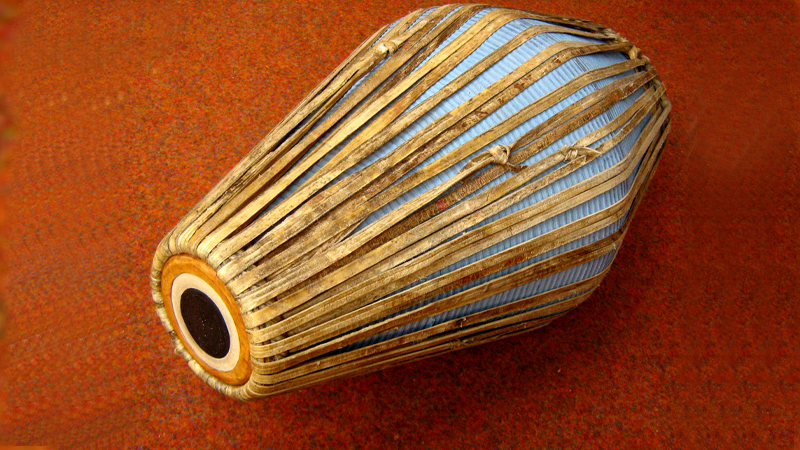khol

The khol is a terracotta two-sided drum used in northern and eastern India for accompaniment with devotional music (bhakti). It is also known as a mridanga (< Sanskrit mrit + anga, lit. 'clay limb'), not to be confused with mridangam. It originates from the Indian state of West Bengal from elite class-caste groups who brought it to the culture of Assam and Manipur with the spread of the Vaishnavite sect. The drum is played with palms and fingers of both hands.
The most widely used percussion instrument in eastern India is the khol. It is also called mridang, because it is made of clay, i.e. mrit or mud. The instrument is closely associated with Vaishnavite music of Bengal and Assam.
The khol is a barrel shaped asymmetrical drum. Its two faces are of different sizes, and it seems to resemble the ancient Gopuchha shape of drums, as described by Bharat in his Natya Shastra. The right face of the drum, which is three to five inches in diameter, has a high pitch and produces a metallic sound, whereas the left face, which is six to eight inches in diameter, produces a lower bass sound. The relation between the two faces is almost of an octave, i.e. S-S. The drum is made of a special clay, which is available on the banks of the Ganges in Bengal. The two faces of the drum are covered with two layers of cow leather, one full and the other on the outer periphery of the faces. These parchments are held by braids, both of which are connected with thin leather strips equally distributed into thirty-two spaces. Nowadays, in some khols cotton strips are also used. The entire instrument is painted with a paste of flour mixed with red colour. The syahi or the black permanent mixture, that provides a good tonal quality, is also put on the central portion of the right face of the khol like other percussion instruments, but the preparation of this mixture is quite different from the syahi of the tabia or pakhavaj. The syahi used for khol is prepared from mud and rice dust with a tiny portion of iron fillings. The left face of the drum is loaded with mud and rice dust paste in the centre, and is painted red.
The khol is made of fixed pitches and on-the-spot tuning is not possible. However, by putting a wet cloth on the left face of the drum, the note can be lowered a little.
The khol invariably dangles around the neck of the player with the help of a strap and is played with fingers. The instrument is also very popular in Rabindra Sangeet and almost all the folk music forms of Bengal.
Comments
Khol Improvisation
Performed by Samir Chatterjee. Filmed in the gallery for the art of Mughal South Asia and Later South Asia at The Metropolitan Museum of Art on May13, 2013.
A production of the Digital Media Department, The Metropolitan Museum of Art
Produced and Directed by Christopher Noey
Edited by Kate Farrell
Camera by Kelly Richardson and Jessica Glass
Lighting by Ned Hallick
Sound Recording and Post-Production Audio by David Raymond
Production Coordinator: Stephanie Wuertz
Production Assistants: Sarah Cowan, Kate Farrell, Maureen Coyle
Organized by the Department of Musical Instruments
J. Kenneth Moore, Frederick P. Rose curator-in-charge
Jayson Kerr Dobney, Associate Curator and Administrator
Bradley Strauchen-Scherer, Associate Curator
P. Allen Roda, Research Fellow
Susana Caldeira, Assistant Conservator
Joseph Peknik III, Principal Technician
Pamela Summey, Programs Coordinator
Marian Eines, Associate for Administration
- Log in to post comments
- Log in to post comments
- 204 views

Shree Khol, West Bengal, India | World Culture Festival 2016
Shree Khol is a folk music instrument which has been used from the time of Shri Chaitanya Mahaprabhu. 250 artists played the Shree Khol.
Glimpses from the World Culture Festival (WCF), a celebration of the Art of Living’s 35th anniversary, that was held in New Delhi, India between March 11-13, 2016.
Hosted on the world’s largest floating stage of 7 acres, WCF brought together 3.75 million people from 155 countries. The 3-day event was marked by mesmerizing performances by 36,603 artists from around the globe and showcased cultural diversity like never-seen-before. An estimated 1.8 billion people watched the live telecast of the event from 767,463 locations across 188 countries.